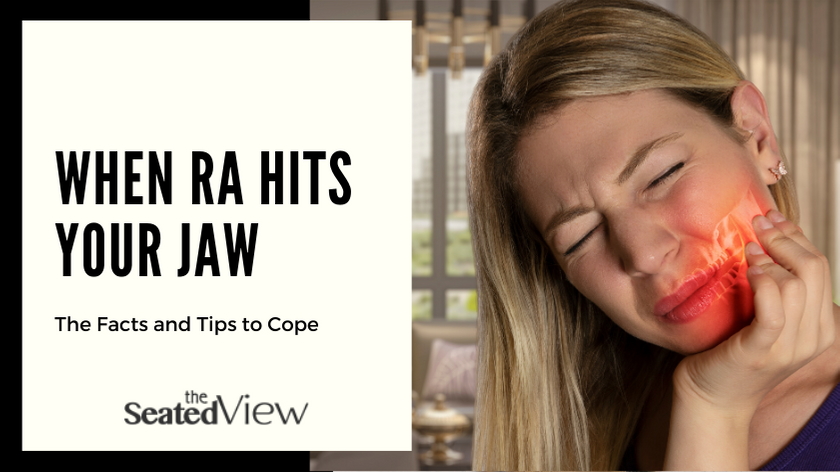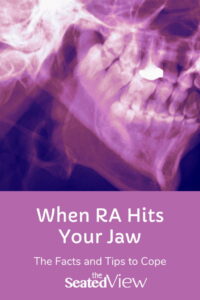When RA Hits Your Jaw: The Facts and Tips to Cope

Did you know that headaches, toothaches, and pain around the neck and shoulders could mean that rheumatoid arthritis (RA) is affecting your jaw? For some of you reading this, this could be the first time you heard that RA can affect your jaw. Let’s cover that first — yes, it can, just like all the other joints. If you have been diagnosed with TMJ, but also have RA, this might be what’s going on. RA jaw pain can be unbelievably debilitating, even affecting your ability to eat and speak. After a lifetime of jaw problems, I’ve developed some tricks to circumvent some of these difficulties. Here’s everything I know about RA in your jaws and how to cope.
The facts about rheumatoid arthritis jaw pain
RA is a systemic autoimmune disease that affects your entire body, including eyes, internal organs, and skin, but the most obvious and well-known is the inflammation in your joints that can cause pain and damage. Although your fingers, wrist, knees and ankles may be more obviously affected, RA can also hit other joints that are less well-known, including your vocal cords and yes, your jaws. The jaw joints — also called the temporomandibular joint (TMJ) — are often busier than other areas. Whether you’re talking, eating, swallowing, sticking out your tongue… your jaw’s involved in all of it.
When RA affects your jaws, it can result in a unique pain that radiates into your entire face, neck, and shoulders, as well as into your mouth, making your teeth hurt or feel loose. Your jaw may also make noise, such as cracking or crunching (called crepitus) and your range of motion can be affected.
Estimates of how many experience RA jaw involvement are… well, they’re a mess. There appears to be no standardized way to measure it, which explains why the incidence of jaws joints affected by RA ranges from 4 to 93 percent. Some articles insist that the jaws are not affected until significant progression of untreated RA, yet the upper estimate of 93 percent seems to indicate that it happens at the exact same rate as other joints. That is, unique to the person. For some, progression is slow, and it’s faster for others.

Treating the cause
The first goal of RA treatment is to stop that progression. Getting your RA effectively suppressed by medication is the single best thing you can do for your joints — jaws and the rest, as it protects your joints and internal organs from permanent damage. Because I grew up in a time when nothing could stop the inflammatory rampage, my jaws are pretty wrecked, with limited mobility, pain, and cracking and crunching when I move it. Also, in profile I look like a bird. This is a classic look for those of us with juvenile arthritis who grew up in the time before treatment — damage to the jaw joints have pulled our chins back a bit.
Biologics have changed my life in many ways and I’m grateful for all of them every day. If you asked me to rank them — completely impossible, but for argument’s sake — I would say that my ability to eat crunchy things again is high on the list. These days, I can eat most crunchy foods, large salads, and tolerate a 40 minute teeth cleaning appointment. That wasn’t the case before Biologics. Treating my disease has made all the difference.
Tips for coping with jaw pain
About three weeks ago, something happened to my jaw. My family doctor says I might have partially dislocated or sprained it, my dentist thinks it was an infected tooth. Either way, I dipped back in the memories of life with a wrecked jaw. Thankfully, I still remembered my tricks and workarounds. Which are as follows:
Eat soft foods. Eat foods that require very little chewing work. Soups, fish, mashed potatoes, yogurt, applesauce, oatmeal. Also: ice cream (it’s therapeutic, really). If opening your mouth to take a bite of something hurts, cut the food into pieces and eat with a fork or spoon — especially one that’s smaller than you would normally use. For instance, using a teaspoon means you don’t have to open your mouth quite as much as you would with a tablespoon.
Don’t eat crunchy or chewy foods. I probably don’t need to spell it out, but will include it just in case. Stay away from gum, caramels, steak, crusty breads, roasted chickpeas. You get it. If it’s got a nice crunch or a lot of chewing, don’t go there.
Chew with your front teeth. When you chew, don’t use your molars — that puts more pressure on the jaw joints and the surrounding muscles. Instead, chew more to the front of your mouth, including using the front incisors. Feels odd, but not quite so painful.
Range of motion exercises. The same principle applies to all your joints: keep them mobile or they might lose range of motion. A couple of exercises can be especially helpful. First, open your mouth very slowly and curl your tongue so the tip touches the roof of your mouth, then close your mouth (slowly again) while keeping the tip of the tongue in position. Second, look at yourself in the mirror and slowly open and close your mouth without moving it from side to side. PS that side-to-side movement may have been what recently messed up my jaw this time.
Moist heat. Applying moist heat to your jaw joints can feel wonderful. Wring out a washcloth or small towel in very hot water — not scalding, you don’t want a burn on top of everything else — and place it on your jaw or cheeks. I also swear by my Magic Bag, which can wrap around aching bits and the heat lasts forever.
Ice it. Although my personal experience is that heat works best for jaw pain, some people respond better to ice. Make sure you wrap your icepack (or bag of frozen peas) in a dishtowel to avoid frostbite and remove the cold pack after 10-20 minutes.
Take the meds. Don’t wait until you can’t stand it anymore —the trick to treating pain effectively is to treat it like a race. Your goal is to get ahead of the pain and the longer you wait to treat it, the further behind you get. Use whatever you have, whether in tablet form or a topical anti-inflammatory (Voltaren gel is good, but then so are Tiger balm, Traumeel, and many others. Experiment until you find your favourite). Since jaw pain is especially good at messing up the muscles supporting the joints, muscle relaxants can also be effective. Talk to your doctor about your options.
Treat your shoulders. My TMJ got really bad when I developed fibromyalgia in 2004 and I ended up at my dentist a number times thinking I had an infected molar. I never did. This was in the early days of the Internet and it took a lot of searching until I found a note by someone who said that TMJ symptoms came from their shoulders. I started treating my shoulders (very affected by fibro) — with heat, ice, topical anti-inflammatory meds, and the odd trigger point steroid injection in my trapezoid muscle. And my jaws felt better.
Get a mouth guard. If you clench or grind your teeth at night, ask your dentist about a mouthguard. This can help prevent that nightly gnashing of teeth and lessen the pain in your jaws.
Use straws. Drinking from a glass can be surprisingly difficult when your jaws acting up, so stock up on straws can help you stay hydrated. If you like reusable straws, I use these with silicone tips to protect your teeth from chipping.
Be thoughtful and careful. Even when your jaw pain isn’t through the roof, be careful and think about what you’re doing. For instance, if you have a habit of resting your chin in your hand, stop. It puts pressure on the jaw and may even affect the alignment. Be careful how wide you open your mouth when eating, speaking or yawning.
Ask for help. It takes a village to get ahead of RA. If your jaw problems are affecting your quality of life, ask your medical team for help. That includes your rheumatologist, your family doctor, your dentist, as well as a physiotherapist and maybe even an occupational therapist.
Did you know that RA can affect your jaw? How do you deal with it?


REFERENCES:
Andersen, Lene. “4 Little-Known Joints Affected by Rheumatoid Arthritis.” HealthCentral. https://www.healthcentral.com/article/4-littleknown-joints-affected-by-rheumatoid-arthritis/?ap=420
Duckworth, Hugh, MD. “RA and Jaw Pain: Rheumatoid Arthritis Cause Jaw Pain?” RheumatoidArthritis. https://www.rheumatoidarthritis.org/ra/jaw-pain/
Greenhalgh, Tom, “Rheumatoid arthritis and jaw pain: what do patients need to know.” Rheumatology Advisor. https://www.rheumatologyadvisor.com/home/topics/rheumatoid-arthritis/rheumatoid-arthritis-and-jaw-pain-what-your-patients-need-to-know/
Hecht, Marjorie. “Can You Get Arthritis in Your Jaw?” Healthline. https://www.healthline.com/health/can-you-get-arthritis-in-your-jaw
“How can rheumatoid arthritis affect job?” Medical News Today. https://www.medicalnewstoday.com/articles/325759
Sodhi, Amandeep, et.al., “rheumatoid arthritis affecting temporomandibular joint.” Journal List Contemp Clin Dent,v.6(1); Jan-Mar 201”5. https://www.ncbi.nlm.nih.gov/pmc/articles/PMC4319332/
Tag: biologics, chronic illness, chronic pain, fibromyalgia, jaw, jaw pain, neck pain, RA, rheumatoid arthritis, shoulder pain, TMJ, treatment
1 Comment
Read More
Discover what else I've been writing about...
















I enjoyed this Lene.
I found out the hard way that arthritis affects the TMJ. I was diagnosed PsA in 2015/2016. In 2017 I had a TMJ total joint replacement (with fat grafts for the disc) on my left side after putting up with symptoms for years which accelerated rapidly at the end. The joint wouldn’t hold together anymore. A that point my right side was acceptable but clunky. Despite maximal medical treatment (bio/MTX/sulphasalazine) 12 months later it too was destroyed by PsA. So I’ve got two artificial 3D printed (custom made for me!) Titanium TMJs. New technology by my world renewed surgeon.
I still get muscle tightness and pain with flares, but my jaw functions very well! Advice is not to overwork the jaw with crunchy foods, whole apples etc It should technically last 20 years. The old technology joints last around 10 years.
I have rapidly erosive disease apparently. My body still works quite well on the whole. (most days) I make every effort to stay strong and active. Using Pilates, splints, pain meds, and modifying my lifestyle all help. Some days I end up stranded on the couch and at home, but that’s OK too.
Keep up the fab posts please Lene. You’re a tough cookie full of wisdom. Thanks!